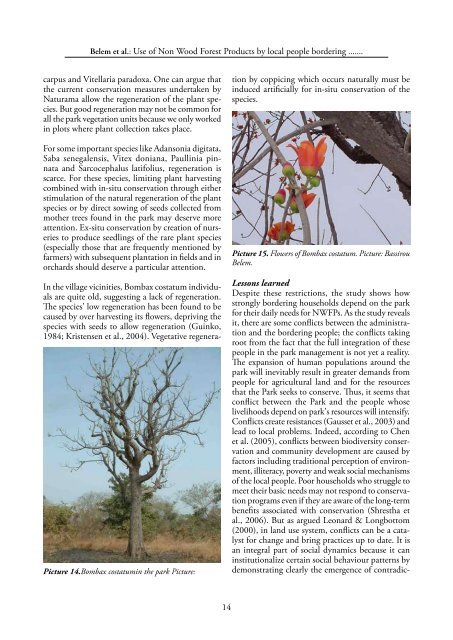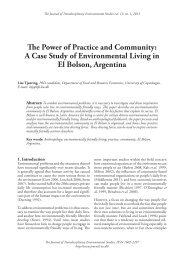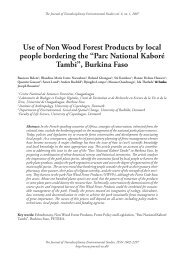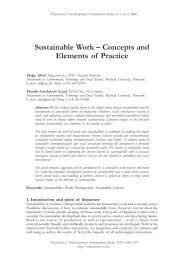Use of Non Wood Forest Products by local people bordering the ...
Use of Non Wood Forest Products by local people bordering the ...
Use of Non Wood Forest Products by local people bordering the ...
- No tags were found...
You also want an ePaper? Increase the reach of your titles
YUMPU automatically turns print PDFs into web optimized ePapers that Google loves.
Belem et al.: <strong>Use</strong> <strong>of</strong> <strong>Non</strong> <strong>Wood</strong> <strong>Forest</strong> <strong>Products</strong> <strong>by</strong> <strong>local</strong> <strong>people</strong> <strong>bordering</strong> .......carpus and Vitellaria paradoxa. One can argue that<strong>the</strong> current conservation measures undertaken <strong>by</strong>Naturama allow <strong>the</strong> regeneration <strong>of</strong> <strong>the</strong> plant species.But good regeneration may not be common forall <strong>the</strong> park vegetation units because we only workedin plots where plant collection takes place.For some important species like Adansonia digitata,Saba senegalensis, Vitex doniana, Paullinia pinnataand Sarcocephalus latifolius, regeneration isscarce. For <strong>the</strong>se species, limiting plant harvestingcombined with in-situ conservation through ei<strong>the</strong>rstimulation <strong>of</strong> <strong>the</strong> natural regeneration <strong>of</strong> <strong>the</strong> plantspecies or <strong>by</strong> direct sowing <strong>of</strong> seeds collected frommo<strong>the</strong>r trees found in <strong>the</strong> park may deserve moreattention. Ex-situ conservation <strong>by</strong> creation <strong>of</strong> nurseriesto produce seedlings <strong>of</strong> <strong>the</strong> rare plant species(especially those that are frequently mentioned <strong>by</strong>farmers) with subsequent plantation in fields and inorchards should deserve a particular attention.Picture 14.Bombax costatumin <strong>the</strong> park Picture:In <strong>the</strong> village vicinities, Bombax costatum individualsare quite old, suggesting a lack <strong>of</strong> regeneration.The species' low regeneration has been found to becaused <strong>by</strong> over harvesting its flowers, depriving <strong>the</strong>species with seeds to allow regeneration (Guinko,1984; Kristensen et al., 2004). Vegetative regeneration<strong>by</strong> coppicing which occurs naturally must beinduced artificially for in-situ conservation <strong>of</strong> <strong>the</strong>species.Picture 15. Flowers <strong>of</strong> Bombax costatum. Picture: BassirouBelem.Lessons learnedDespite <strong>the</strong>se restrictions, <strong>the</strong> study shows howstrongly <strong>bordering</strong> households depend on <strong>the</strong> parkfor <strong>the</strong>ir daily needs for NWFPs. As <strong>the</strong> study revealsit, <strong>the</strong>re are some conflicts between <strong>the</strong> administrationand <strong>the</strong> <strong>bordering</strong> <strong>people</strong>; <strong>the</strong> conflicts takingroot from <strong>the</strong> fact that <strong>the</strong> full integration <strong>of</strong> <strong>the</strong>se<strong>people</strong> in <strong>the</strong> park management is not yet a reality.The expansion <strong>of</strong> human populations around <strong>the</strong>park will inevitably result in greater demands from<strong>people</strong> for agricultural land and for <strong>the</strong> resourcesthat <strong>the</strong> Park seeks to conserve. Thus, it seems thatconflict between <strong>the</strong> Park and <strong>the</strong> <strong>people</strong> whoselivelihoods depend on park's resources will intensify.Conflicts create resistances (Gausset et al., 2003) andlead to <strong>local</strong> problems. Indeed, according to Chenet al. (2005), conflicts between biodiversity conservationand community development are caused <strong>by</strong>factors including traditional perception <strong>of</strong> environment,illiteracy, poverty and weak social mechanisms<strong>of</strong> <strong>the</strong> <strong>local</strong> <strong>people</strong>. Poor households who struggle tomeet <strong>the</strong>ir basic needs may not respond to conservationprograms even if <strong>the</strong>y are aware <strong>of</strong> <strong>the</strong> long-termbenefits associated with conservation (Shrestha etal., 2006). But as argued Leonard & Longbottom(2000), in land use system, conflicts can be a catalystfor change and bring practices up to date. It isan integral part <strong>of</strong> social dynamics because it caninstitutionalize certain social behaviour patterns <strong>by</strong>demonstrating clearly <strong>the</strong> emergence <strong>of</strong> contradic-14






